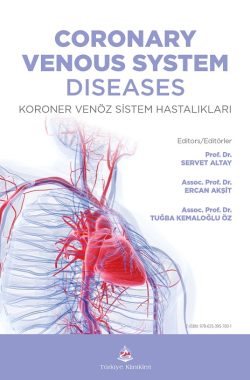CORONARY VENOUS SYSTEM, HEART FAILURE AND CORONARY ARTERY DISEASE
Uğur Özpınar1 Ahmet Barutçu2
1Çanakkale Mehmet Akif Ersoy State Hospital, Department of Cardiology, Çanakkale, Türkiye
2Çanakkale Onsekiz Mart University, Faculty of Medicine , Department of Cardiology, Çanakkale, Türkiye
Özpınar U, Barutçu A. Coronary Venous System, Heart Failure and Coronary Artery Disease. In: Altay S, Akşit E, Kemaloğlu Öz T editor. Coronary Venous System Diseases. 1st ed. Ankara: Türkiye Klinikleri; 2025. p.85-89.
ABSTRACT
Recent evidence highlights the coronary venous system (CVS) as a rather dynamic entity than as a passive anatomical conduit, with critical implications in both coronary artery disease (CAD) and heart failure (HF). A full comprehension of the pathophysiological interplay between certain coro- nary venous dynamics and myocardial ischemia offers a new perspective in thoroughly evaluating and managing certain cardiovascular diseases. Elevated coronary sinus pressure, impaired venous drain- age, and resultant venous congestion have been increasingly recognized as meaningful contributors to myocardial dysfunction, ischemia, and adverse cardiac remodeling. In this setting, strategies focused on the coronary venous system, such as the coronary sinus reducer device, are seen as viable treatments for those who have refractory angina and chronic myocardial ischemia, showing better clinical results and life quality. In heart failure patients, alterations in coronary venous hemodynamics may influence myocardial perfusion as well as ventricular function. This represents a potential therapeutic target, thus affecting clinical prognosis. This chapter almost comprehensively reviews some anatomical and phys- iological characteristics within the coronary venous system, elucidates its relationship with coronary artery disease plus heart failure, and explores certain contemporary therapeutic applications, including the clinical role for the coronary sinus reducer device. Also, the present literature derived from certain clinical trials and expert consensus documents is summarized to give an evidence-based understanding of the importance and clinical utility of targeting the coronary venous system in cardiology practice.
Keywords: Coronary artery disease; Heart failure; Myocardial infarction; Myocardial ischemia; Ventricular remodeling
Kaynak Göster
Referanslar
- Camici PG, d'Amati G, Rimoldi O. Coronary microvascular dysfunction: mechanisms and functional assessment. Nat Rev Cardiol. 2015;12(1):48-62. [Crossref] [PubMed]
- Konijnenberg LSF, Damman P, Duncker DJ, et al. Pathophysiology and diagnosis of coronary microvascular dysfunction in ST-elevation myocardial infarction. Cardiovasc Res. 2020;116(4):787-805. [Crossref] [PubMed] [PMC]
- Garg P, Underwood SR, Senior R, Greenwood JP, Plein S. Noninvasive cardiac imaging in suspected acute coronary syndrome. Nat Rev Cardiol. 2016;13(5):266-275. [Crossref] [PubMed]
- Meisel E, Pfeiffer D, Engelmann L, Tebbenjohanns J, Schubert B, Hahn S. Investigation of coronary venous anatomy by retrograde venography in patients with malignant ventricular tachycardia. Catheter Cardiovasc Interv. 2001;54(4):485-494. [Crossref] [PubMed]
- Auricchio A, Prinzen FW. Enhancing response in the cardiac resynchronization therapy patient: the 3B perspective-bench, bits, and bedside. JACC Clin Electrophysiol. 2017;3(11):1203-1219. [Crossref] [PubMed]
- Verheye S, Jolicœur EM, Behan MW, et al. Efficacy of a device to narrow the coronary sinus in refractory angina. N Engl J Med. 2015;372(6):519-527. [Crossref] [PubMed] [PMC]
- Theofilis P, Vlachakis PK, Sagris M, et al. The Efficacy of Coronary Sinus Reducer in Patients with Refractory Angina: A Systematic Review and Meta-Analysis. Rev Cardiovasc Med. 2024;25(3):82. Published 2024 Mar 4. [Crossref] [PubMed] [PMC]
- Giannini F, Baldetti L, Ponticelli F, et al. Coronary Sinus Reducer Implantation for the Treatment of Chronic Refractory Angina: A Single-Center Experience. JACC Cardiovasc Interv. 2018;11(8):784-792. [Crossref] [PubMed]
- Konigstein M, Giannini F, Banai S. The Reducer device in patients with angina pectoris: mechanisms, indications, and perspectives. Eur Heart J. 2018;39(11):925-933. [Crossref] [PubMed]
- Giannini F, Tzanis G, Ponticelli F, et al. Technical aspects in coronary sinus Reducer implantation. EuroIntervention. 2020;15(14):1269-1277. [Crossref] [PubMed]
- Mrak M, Bunc M. Coronary sinus reducer therapy in re fractory angina: current evidence and future considerations. Pol Arch Intern Med. 2025;135(5):17022. [Crossref] [PubMed]
- Zile MR, Bennett TD, St John Sutton M, et al. Transition from chronic compensated to acute decompensated heart failure: pathophysiological insights obtained from continuous monitoring of intracardiac pressures. Circulation. 2008;118(14):1433-1441. [Crossref] [PubMed]
- Boorsma EM, Ter Maaten JM, Damman K, et al. Congestion in heart failure: a contemporary look at physiology, diagnosis and treatment. Nat Rev Cardiol. 2020;17(10):641-655. [Crossref] [PubMed]
- Mullens W, Verbrugge FH, Nijst P, Tang WHW. Renal sodium avidity in heart failure: from pathophysiology to treatment strategies. Eur Heart J. 2017;38(24):1872-1882. [Crossref] [PubMed]
- Mentz RJ, O'Connor CM. Pathophysiology and clinical evaluation of acute heart failure. Nat Rev Cardiol. 2016;13(1):28-35. [Crossref] [PubMed]
- Cleland JGF, Pellicori P, Clark AL, Petrie MC. Time to Take the Failure Out of Heart Failure: The Importance of Optimism. JACC Heart Fail. 2017;5(7):538-540. [Crossref] [PubMed]
- Auricchio A, Stellbrink C, Butter C, et al. Clinical efficacy of cardiac resynchronization therapy using left ventricular pacing in heart failure patients stratified by severity of ventricular conduction delay. J Am Coll Cardiol. 2003;42(12):21092116. [Crossref] [PubMed]
- St John Sutton MG, Plappert T, Abraham WT, et al. Effect of cardiac resynchronization therapy on left ventricular size and function in chronic heart failure. Circulation. 2003;107(15):1985-1990. [Crossref] [PubMed]
- Banai S, Ben Muvhar S, Parikh KH, et al. Coronary sinus reducer stent for the treatment of chronic refractory angina pectoris: a prospective, open-label, multicenter, safety feasibility first-in-man study. J Am Coll Cardiol. 2007;49(17):17831789. [Crossref] [PubMed]
- Akşit E, Barutçu A, Şehitoğlu MH, et al. Association of abnormal coronary sinus reflux with coronary slow flow and importance of the Thebesian valve. Int J Cardiol. 2020;319:26-31. [Crossref] [PubMed]

